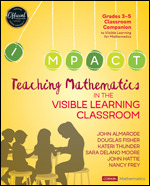Teaching Mathematics in the Visible Learning Classroom, Grades 3-5
- John Almarode - James Madison University, USA
- Douglas Fisher - San Diego State University, USA
- Kateri Thunder
- Sara Delano Moore - Mathematics Consultant
- John Hattie - The University of Melbourne, Australia
- Nancy Frey - San Diego State University, USA
Corwin Mathematics Series
In this sequel to the megawatt best seller Visible Learning for Mathematics, John Almarode, Douglas Fisher, Nancy Frey, John Hattie, and Kateri Thunder help you answer that question by showing how Visible Learning strategies look in action in the mathematics classroom. Walk in the shoes of elementary school teachers as they engage in the 200 micro-decisions-per-minute needed to balance the strategies, tasks, and assessments seminal to high-impact mathematics instruction.
Using grade-leveled examples and a decision-making matrix, you’ll learn to
- Articulate clear learning intentions and success criteria at surface, deep, and transfer levels
- Employ evidence to guide students along the path of becoming metacognitive and self-directed mathematics achievers
- Use formative assessments to track what students understand, what they don’t, and why
- Select the right task for the conceptual, procedural, or application emphasis you want, ensuring the task is for the right phase of learning
- Adjust the difficulty and complexity of any task to meet the needs of all learners
It’s not only what works, but when. Exemplary lessons, video clips, and online resources help you leverage the most effective teaching practices at the most effective time to meet the surface, deep, and transfer learning needs of every student.
Free resources
Peer-Assisted Reflection (PAR) for Mastery
This Peer-Assisted Reflection (PAR) activity from Teaching Mathematics in the Visible Learning Classroom, Grades 3-5, helps you develop strategies for process feedback, which is critical as learners explore the why and the how of specific mathematics content.

